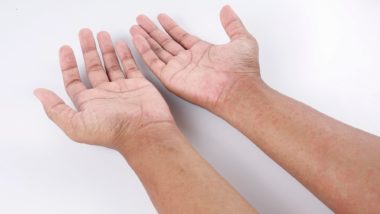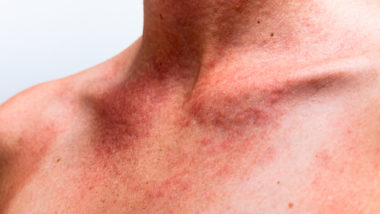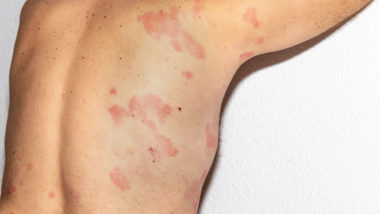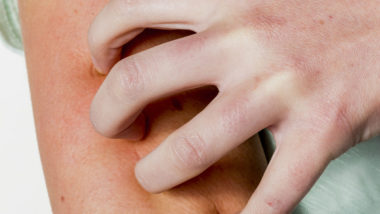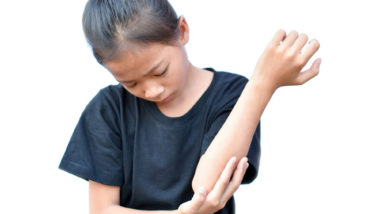Top Class Actions’s website and social media posts use affiliate links. If you make a purchase using such links, we may receive a commission, but it will not result in any additional charges to you. Please review our Affiliate Link Disclosure for more information.
Those with a family member or loved one experiencing the painful and dangerous skin condition known as Stevens-Johnson Syndrome may be wondering, “Is Stevens-Johnson Syndrome contagious?” Though it may appear as though it could spread from person to person, the rash associated with this syndrome is actually a sign of a severe allergic reaction to a virus or medication. Read on to learn more about the condition and the common misconceptions that surround it.
Are Skin Rashes Contagious?
Skin conditions are among the most stigmatized health problems a person can develop. They are often visible to the public, and there is a common misconception that all rashes are potentially contagious. Those with visible skin conditions and rashes often face the discomfort of those who don’t understand why the rash developed on top of the pain and embarrassment of the conditions themselves.
According to Everyday Health, some of the most common skin conditions aren’t actually contagious. Non-contagious conditions often mistaken for contagious ones include psoriasis, hives, poison ivy, eczema, vitiligo, and rosacea.
What is Stevens Johnson Syndrome?
Stevens-Johnson Syndrome and its counterpart, toxic epidermal necrolysis (TEN), are serious skin conditions usually caused by adverse reactions to medications, though they can also be caused by infections. Stevens-Johnson Syndrome is the less severe version of TEN, but they are considered to be the same condition and both affect the skin and mucous membranes. This condition first appears as a fever but soon develops into red or purple rashes and blisters resembling burns. These rashes kill the skin, causing it to peel off.
Several medications may cause Stevens Johnson Syndrome. Most commonly, the reaction occurs after the patient has been prescribed anti-gout medications such as allopurinol, anticonvulsant medications for the treatment of seizures, antipsychotics for mental illness, antibacterial sulfonamides, nevirapine, or pain relievers including acetaminophen, ibuprofen, and naproxen.
Stevens-Johnson Syndrome and TEN are both very rare. The National Institutes of Health (NIH) estimates that between 1 million and 2 million people are affected by these conditions each year. However, those who are HIV-positive or have specific types of lupus may be more likely to develop Stevens-Johnson Syndrome, though the reason is unclear. Other at-risk groups include bone marrow transplant recipients and those with chronic diseases of the joints and connective tissues.
Is Stevens Johnson Syndrome Contagious?
Now that you know what Stevens-Johnson Syndrome is, we can answer the question: “Is Stevens-Johnson Syndrome contagious?” Given the causes of this condition, it should be no surprise to learn that the common fear of it spreading from person to person is unfounded.
If you have a loved one with the condition, they will need your support, and you can provide it without fear of contracting the condition yourself. That being said, if one of your family members develops Stevens-Johnson Syndrome, you should also avoid whatever medication caused the condition in your relative as there may be a genetic component at play. Instead of wondering is Stevens Johnson Syndrome contagious, you may want to investigate whether you may be at risk of developing the condition from a medication.
How Does Stevens Johnson Syndrome Begin?
Usually, Stevens-Johnson Syndrome first appears as fever or flu-like symptoms. Within days, the skin will begin to blister and peel, forming raw areas called erosions. This is an incredibly painful process that creates rashes that resemble severe water burns.
These burn-like rashes usually start on the face and chest but can spread to cover as much as 30 percent of the body’s surface in those with severe TEN cases. This condition also damages mucus membranes like the lining of the mouth and airways. This can cause trouble breathing and swallowing. The condition may further affect the urinary tract and genitals and can cause severe damage to the eyes, specifically the cornea and mucus membranes protecting the white parts of the eye.
Those who survive the condition are likely to face a variety of long-term health concerns. First, the skin of those affected may face changes in pigmentation, dryness, and scarring. Survivors may also experience hair loss, excess sweating, and abnormal growth or loss of fingernails and toenails. Mucous membrane damage may result in impaired taste, genital abnormalities, and difficulty urinating. In rare cases, survivors may develop chronic inflammation or dryness of the eyes. This can lead to increased light sensitivity or vision impairment. The damage caused by Stevens Johnson Syndrome may be permanent for some patients, resulting in long term skin damage, hair loss, or vision loss.
Treatment for Stevens Johnson Syndrome
Treatment for Stevens Johnson Syndrome generally begins with the diagnosis of the condition and the immediate cessation of the medication responsible for causing the reaction. Depending on the severity of the burns and skin damage, patients may be transferred to an intensive care unit or burn unit for their treatment.
Ongoing treatment for the condition may include fluid replacement, as well as supplemental nutrition, often given through a nasogastric tube. Wound care, including the removal of dead skin, and treatment with medical dressings, petroleum jelly, or cool compresses may also help to soothe affected areas while they heal. For patients who experience vision loss or damage to their mucus membranes, it may be required that they meet with specialists to determine how to treat their injuries.
Medications including antibiotics and anti-inflammatories may also be used to prevent infections and reduce swelling and pain. Depending on the severity of the injuries and the course of treatment, new skin may begin to grow over affected areas within several days. However, it may take victims of the serious syndrome many months to fully recover.
Is Stevens Johnson Syndrome Fatal?
Stevens-Johnson Syndrome and TEN can cause severe damage to the skin and mucus membranes. This makes the condition potentially life-threatening.
According to the NIH, the skin is meant to serve as a protective barrier, and extensive damage to that barrier can lead to extreme fluid loss and the development of dangerous infections. Complications associated with Stevens-Johnson Syndrome include pneumonia, shock, bacterial infections (sepsis), multiple organ failure, and even death. Roughly 10 percent of those who develop Stevens-Johnson Syndrome die. The more deadly condition, TEN, has a 50 percent fatality rate.
Cases of Stevens Johnson Syndrome
A woman diagnosed with Stevens Johnson Syndrome told The Sun that she initially thought her symptoms stemmed from the flu or a strained muscle. Christine R. said she began taking a drug to treat her arthritis in September 2018. Within a week of starting the medication, she began experiencing swelling in her legs, as well as aches and pains. When the symptoms worsened, she went to the hospital, where she developed water blisters and painful swelling across her body.
In order to care for Christine while her body fought the dangerous condition, hospital staff kept her sedated and on oxygen for two weeks. After weeks of wound care and blister dressings, Christine finally began to recover. However, even after leaving the hospital, she continues to suffer lasting damage. Her skin has been left dry and damaged, and she must use Vaseline to keep it moisturized to prevent painful cracking. Additionally, she has nerve damage, which makes it difficult for her to leave the house. She has also stopped taking the arthritis medication, and is too afraid to try another drug due to the severity of her reaction.
Is Stevens-Johnson Syndrome contagious? No. Is it serious, and can it cause permanent skin and nerve damage if you survive? Yes.
Join a Free Stevens Johnson Syndrome Symptoms & Toxic Epidermal Necrolysis Lawsuit Investigation
You may qualify for this investigation under the following circumstances:
- You or loved one took an over-the-counter or prescription drug that caused you to develop SJS or TEN;
- You or your loved one was diagnosed with SJS or TEN; and
- You or your loved one was hospitalized because of SJS or TEN.
You may be able to hold the drug company accountable by joining this Stevens Johnson Syndrome lawsuit investigation.
See if you qualify by filling out the form on this page.
ATTORNEY ADVERTISING
Top Class Actions is a Proud Member of the American Bar Association
LEGAL INFORMATION IS NOT LEGAL ADVICE
Top Class Actions Legal Statement
©2008 – 2024 Top Class Actions® LLC
Various Trademarks held by their respective owners
This website is not intended for viewing or usage by European Union citizens.
Get Help – It’s Free
Join a Free Stevens Johnson Syndrome Symptoms & Toxic Epidermal Necrolysis Lawsuit Investigation
If you qualify, an attorney will contact you to discuss the details of your potential case at no charge to you.
PLEASE NOTE: If you want to participate in this investigation, it is imperative that you reply to the law firm if they call or email you. Failing to do so may result in you not getting signed up as a client or getting you dropped as a client.
Oops! We could not locate your form.




